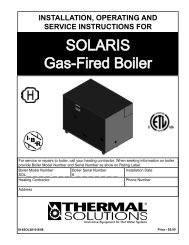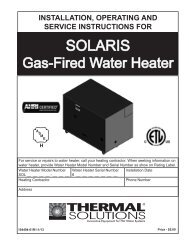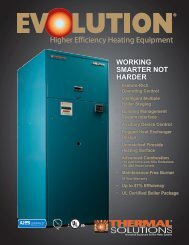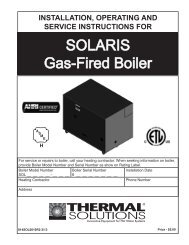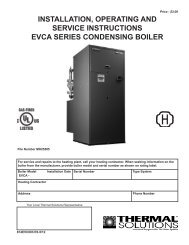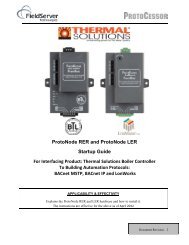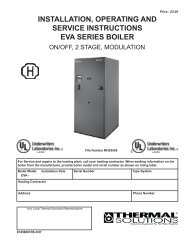I&O Manual - ECCS Control System - Categories On Thermal ...
I&O Manual - ECCS Control System - Categories On Thermal ...
I&O Manual - ECCS Control System - Categories On Thermal ...
Create successful ePaper yourself
Turn your PDF publications into a flip-book with our unique Google optimized e-Paper software.
Section 2: Principles of Operation<br />
2.1 SYSTEM DESCRIPTION<br />
The <strong>ECCS</strong> (Electronic <strong>Control</strong>s and Communication<br />
<strong>System</strong>) is a Lead Lag sequencer for modulating and<br />
on/off boilers capable of auto rotation, Outdoor reset,<br />
and communication using a Modbus protocol.<br />
All the control signals between the boiler and the <strong>ECCS</strong><br />
panel are transmitted over a 3 wire shielded cable using<br />
the Modbus protocol. This includes the enable/disable<br />
signal, the modulating signal, and the local/remote<br />
signal.<br />
<strong>System</strong> water temperature is continuously monitored<br />
through the header water temperature sensor. The<br />
system compares this temperature to the setpoint which<br />
is fixed or generated from the outdoor reset curve. If<br />
the system water temperature falls below the adjustable<br />
system ON POINT set on the screen (refer to Figure<br />
5.3) the lead boiler will turn on via a signal from the<br />
<strong>ECCS</strong> system. For a modulating boiler, The PID<br />
control will generate a signal and send it to the boilers<br />
via the MODBUS. If the firing rate goes above the<br />
START TRIGGER Point set on the screen for the<br />
amount of time set in the START DELAY, the first lag<br />
boiler will start. <strong>On</strong>ce the lag boiler starts it will drive<br />
to the same firing rate as the lead boiler. Both boilers<br />
will fire in tandem, at the same firing rate. Additional<br />
lag boilers will start by the same criteria in the order<br />
that set as the LEAD LAG SEQUENCE. Boilers will<br />
be shed in the reverse order of which they came on<br />
(AKA: First <strong>On</strong>, Last Off). As load is shed the boilers<br />
will use the STOP TRIGGER point and the STOP<br />
DELAY parameters set on the screen.<br />
For <strong>On</strong>/Off boilers, additional boilers will be added<br />
when the system water temperature drops below the<br />
system ON POINT for the time set in the boiler START<br />
DELAY. Boilers will be shed in reverse order using<br />
the OFF POINT and STOP DELAY parameters.<br />
The Lead Lag (LL) system will be capable of running a<br />
maximum number of 6 boilers. Parameters in the<br />
temperature controller and flame safeguard are<br />
transmitted via the Modbus connection to the PLC and<br />
Touch screen.<br />
2.2 LEAD LAG<br />
2.2.1. In a Lead Lag (LL) system (refer to Figure 5.4),<br />
one boiler is designated as a lead boiler. The lead<br />
boiler will always be the first boiler to come on and the<br />
last boiler to shut off. The lag boilers will always<br />
come on after the lead in order of their number. The<br />
first lag (lag#1) will always be the second boiler to<br />
come on, the second lag (lag#2) will always be the<br />
third to come on, etc. They will turn off in reverse<br />
order.<br />
6<br />
2.2.2. There is a sequence preprogrammed from the<br />
factory as a default of: Lead = boiler 1, Lag #1 =<br />
boiler 2, Lag #2 = boiler 3, etc., in sequential order.<br />
Sequence can be changed to any order that is<br />
desired. Numbers cannot be duplicated or out of<br />
range.<br />
2.2.3. To change the lead lag sequence go to the<br />
SEQUENCE AND ROTATION SCREEN<br />
(Figure 5.5). From the main screen press the system<br />
setup button, then the Enter Lead Lag Sequence<br />
button.<br />
2.2.4. The system will turn on the lead boiler when the<br />
temperature drops below the <strong>System</strong> ON POINT. The<br />
boiler will turn the lead off only if it is the only<br />
boiler running and the temperature is above the<br />
<strong>System</strong> OFF POINT.<br />
The <strong>ECCS</strong> system turns on additional boilers when the<br />
firing rate of the lead boiler rises above the START<br />
TRIGGER (See Figure 5.4: Lead Lag Trigger Setup<br />
Screen) point for the length of time in the BOILER<br />
START DELAY box. The START TRIGGER is the<br />
percentage of the firing rate that a modulating boiler<br />
must reach in order to start the delay timer. <strong>On</strong>ce the<br />
delay timer finishes timing, the next boiler in the<br />
sequence will start. If the firing rate drops below the<br />
START TRIGGER before the timer is complete, the<br />
timer will reset.<br />
ON/OFF boilers will sequence in accordance with the<br />
<strong>System</strong> ON and OFF POINTS. See Figure 5.4 under<br />
Setpoint differential.<br />
2.3. UNAVAILABLE BOILERS<br />
2.3.1. If a boiler is unavailable for any one of the<br />
following reasons the LL sequence will remove them<br />
and adjust the sequence until they become available<br />
again. The purpose of this is to save time between<br />
stages if there is an unavailable boiler. If the<br />
desired lead boiler is unavailable, Lag #1 will<br />
become the lead and other boilers will shift<br />
accordingly. The program will rotate based on the<br />
sequence that has been entered onto the screen.<br />
Flame fail – If the boiler has a flame failure the boiler<br />
will be removed from the LL sequence until the unit<br />
has been reset.<br />
Boiler in Local mode – If the Local/Remote switch is<br />
in Local the boiler will be removed from the LL<br />
sequence until the unit has been placed back in<br />
Remote.



